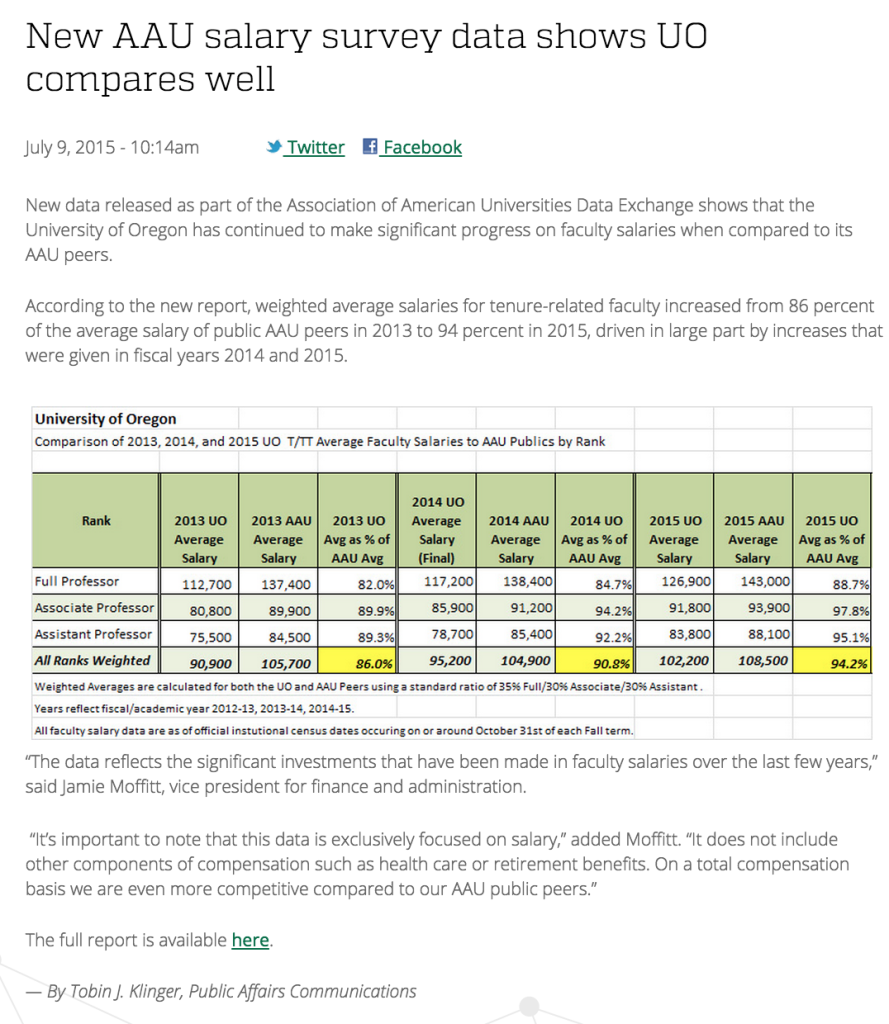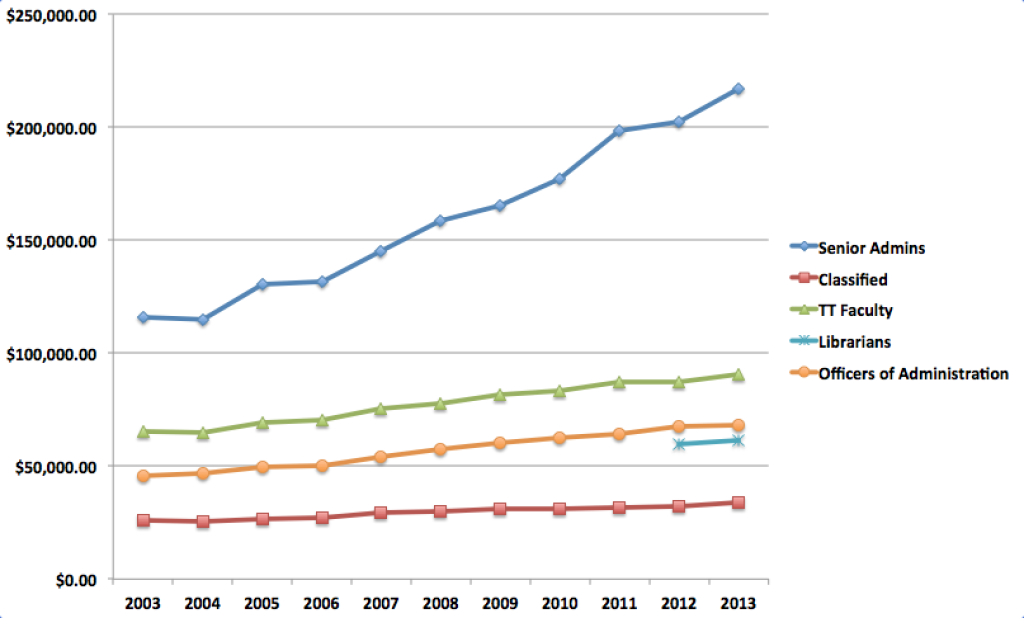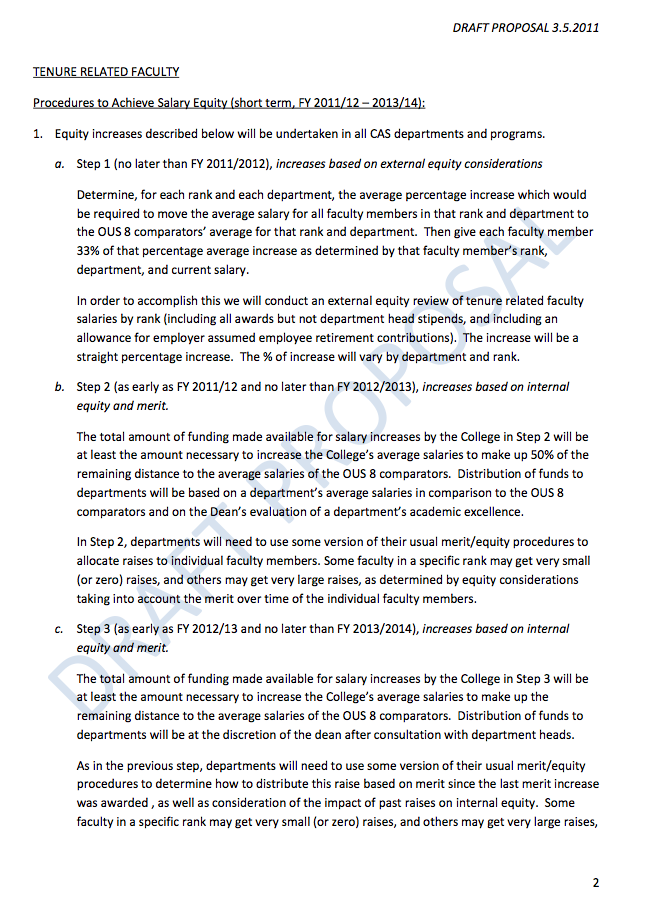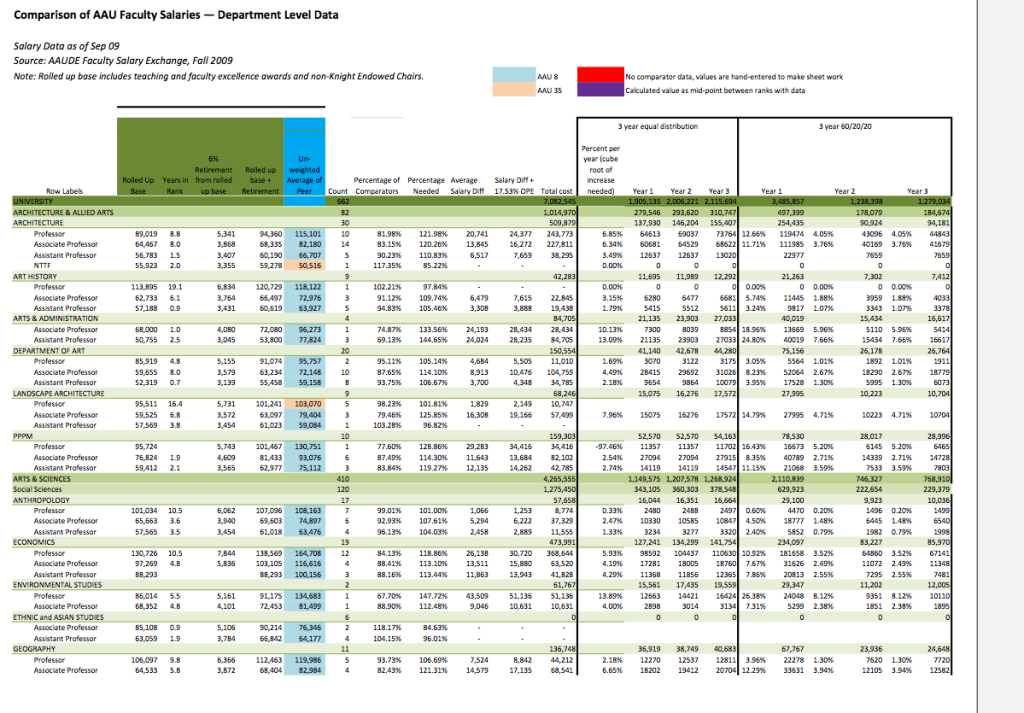Last updated on 07/14/2015
The administration has had these data for weeks, and what with union bargaining restarting Friday at 9AM, I’m sure it’s coincidental that Chief Strategic Communicator Tobin Klinger put the numbers up on “Around the 0” on Thursday:
Raises? You call those raises? Check the UO Institutional Research data for what UO’s senior admin’s get:
The 2009 Lariviere/Coltrane/Bean plan was to get average UO faculty pay by rank and department to 100% of the AAU averages by “No later than” July 2014:
From: James Bean [mailto:jcbean@uoregon.edu]
Sent: Sunday, June 07, 2009 12:26 PM
To: Deans Working Group
Subject: Faculty Salaries
The Missouri article stating that UO has the lowest salaries in the AAU has caused quite a stir (we have since verified that they were correct). Low salaries were always thought of as just Oregonian. But 34 out of 34 is a whole other thing. We cannot have this. Richard’s reaction was “this is job #1.” Richard will likely have an announcement on how we are attacking this when politically feasible (after last gavel). Please communicate to your faculty that the Missouri article really got our attention. This may require disruptive solutions.
Thanks, Jim
_______________________________
James C. Bean
Senior Vice President and Provost
Five days later, the Register Guard’s Editors essentially endorsed Lariviere’s plan to get UO faculty to the AAU averages:
The market for academic talent is national, even global. From a salary standpoint, Oregon has dropped out of the competition. The state is fortunate in having universities that continue to meet high standards, but Oregon’s advantages — a relatively low cost of living and a high quality of life — can only be relied upon to make up part of the salary deficit.
Richard Lariviere, who will become president of the UO in July, comes to Eugene from the University of Kansas, an AAU university with an average faculty salary of $91,400 — 25 percent higher than at the UO. He’s no doubt aware that higher education claimed 15.1 percent of Oregon’s general fund budget in 1987-89, but received only 6.4 percent in 2007-09. One of Lariviere’s continuing challenges will be to persuade Oregon’s governor and Legislature that underfunding higher education has consequences.
In March 2011 Scott Coltrane, at the time CAS Dean, announced his plans to implement this for CAS faculty:
Russ Tomlin, then VP for Academic Affairs, released a detailed spreadsheet showing the plan for the entire UO:
But apparently it only got implemented for the Johnson Hall insiders.




When you include superior retirement benefits here — the real value as best as can be determined, not the money going to cover PERS deficits for the already retired — it looks like UO is right around 100% in total compensation, compared to the average of AAU public universities. A far cry better than back in 2000 when UO first announced its “white paper” plan to raise faculty compensation. (True, that was relative to our 8 OUS external “comparators” not the aggregate of all AAU publics).
As best I can recall, we were somewhere in the mid-80’s % in total compensation back then, so there has been a big change. It took place gradually, though evidently, there has been a good jump the past few years.
When you compare the actual academic standing of UO compared to the midrange of AAU publics, our total compensation is looking pretty good. Especially when you consider that we’re in Eugene, not a lot of other places (though Santa Barbara or Boulder or Seattle are not so terrible either, let us not forget).
Without going into who deserves credit — I think it is pretty widely shared — that is quite an achievement for UO.
I hope the UO administration, which has been timid as a mouse family the last few years, will have the good sense to publicize this far and wide, even if it ruffles some feathers — to mix the animal metaphor a bit, it is a diverse menagerie.
Maybe time to stop bemoaning and start celebrating our “fate,” drink a toast or two, then concentrate on things like infrastructure, helping students succeed at UO and making their way in the world, research money, and achievement, and a host of other things?
superior benefits? what happens when those get added into the spreadsheet for everyone else and not just UO? Benefits are much better at many other institutions, even non-AAU places. When you add in other important factors available elsewhere (such as competent administration and support staff, adequate infrastructure inside SAFE buildings), UO cannot compete (except in athletics, i.e. football).
Keep drinking the kool-aide and hope the big one comes during the summer when the campus is vacant.
Honest Uncle Bernie rightly reminds us not to undersell insurance and retirement, but let’s not forget the non-salary, non-benefits benefits that many other institutions offer faculty that ours does not. For example, many places offer childcare or childcare subventions, or housing or housing subventions. Faculty and staff are penalized for having children, quite honestly.
Those housing subventions generally occur in places with extremely high housing costs, right? And they limit the amount one can gain in a housing boom. I’ve known a number of people who have gotten those subventions in places with sky-high housing costs, who grouse about having to live in “the faculty ghetto” or something similarly odious. They say they envy me living in a place with “reasonable” housing costs. Not a few of them envy the chance to live in a relatively safe neighborhood.
I can’t speak to child care or obviously to all possible fringe benefits. (Or living conditions: not a few people would envy the possibility of driving their kids to the Oregon Coast any weekend they want.) My point is that I don’t think we have it so bad, and in any case, it’s far, far better comparatively than it was just 15 years ago.
Well, I’ve often presented the best data I can come up with re pension benefits at UO. If you can come up with better data, please let us know.
As a Tier 1 ORP member, I know I am getting 22.5% of salary dumped into TIAA each month, without a penny from me going into that. If you know another university that does that, I’d like to know. (Oh, and PERS has given me close to 8% on my old PERS account for the past 15 years or so, while the market has only yielded about 5%. But I don’t even count that when making my claim, because it varies so much from person to person.)
Others of course get less in pension benefits, which has to be factored into the calculations. A job for the UO administration to perform and then publicize, if they were up to both tasks.
As I said in my original post, maybe now concentrate on upgrading infrastructure? Including doing earthquake upgrades, if deemed worthwhile.
But guess what, the Oregon Legislature can’t even seem to come up with dough to upgrade the state Capitol building, so I wouldn’t hold my breath waiting for them on Klamath Hall or whatever the worst building on campus is.
Better hope that the UO Board convinces the right people that it’s worth doing.
Meanwhile, thanks for the tip about the kool-aid — but I think I’ll stick with pomegranate juice.
hUB- recent hires get nowhere close to that Tier 1 deal (which is a good deal). Health care costs must eat up that 22.5% for the rest of the worker bees that will have to find a way to live off of the nectar and honey some day.
The massive divide between the old and new realities for recent and incoming UO hires is going to do nothing towards healing the rift between admin/tier 1 faculty and everyone else.
Of course, I’m well aware that current Tier 3 pension benefits are not as good a deal as Tier 1 — they are worth something like 12-14% for Tier 3 as opposed to 22% for Tier 1 (which fluctuates, hasn’t always been that good in recent memory).
I’m also aware that full professors are below associates and assistants (in %) in that salary chart — the typical difference in pension benefits probably has some correlation with that, i.e., the typical full professor is Tier 1 or Tier 2 and getting lower comparative salary in light of higher pension benefits. (Of course, this is an oversimplification, and also, by 2015, the discrepancy had become less.)
So if you’re saying that new hires have it bad compared to Tier 1 — I don’t buy it. Until very recently, total compensation for Tier 1 faculty badly lagged more recent hires (again, %-wise) — because of horrible salary compression.
I’m not sure what your point is about health care costs. Are our health benefits inferior to other schools? Paying only 5% is a better deal than I had at my previous academic employer.